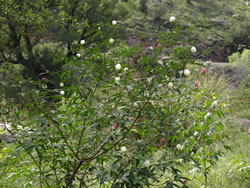Desert Cotton (Gossypium thurberi)
 Gossypium thurberi range map. USDA PLANTS Database.
Gossypium thurberi range map. USDA PLANTS Database.
 Close-up of desert cotton with red spots at base of petals. Photo by M. Falk.
Close-up of desert cotton with red spots at base of petals. Photo by M. Falk.
This handsome shrub or small tree is another member of the Malvaceae family. It is a relative of the cultivated cotton plant. In Spanish it is known as algodoncillo, meaning “little cotton”.
It blooms from May to October, and is found in rocky canyons and slopes in riparian areas, grasslands, and oak woodlands up to 6,000 feet in elevation.
The flowers are pale yellow, with red to pink spots at the base of the petals. The plant can reach heights of 15 feet. The palmate leaves vary in size depending on available moisture, but turn a brilliant red and maroon in the fall.
Desert cotton produces small “bolls”, but the amount of cotton in the fruit is very small, and the plant has no commercial value. In the 1930’s, desert cotton bolls were thought to harbor the cotton boll weevil and attempts were made to eradicate the plant from southern Arizona. It was later determined that the weevil in the desert cotton was a different subspecies than the one that attacks cultivated cotton.
Desert cotton is an attractive garden plant and can be purchased from nurseries in southern Arizona. It is native to southern Arizona and Mexico.


